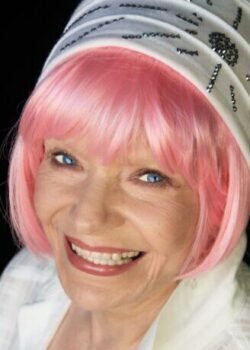Magic Words Make Life Better
November is the month when winter gets serious, delighting skiers and little kids. It’s the time to put the thick, grooved, grab-the-road tires on my car and it’s when I celebrate my magical day! November 18 is my birthday.
On that day I get to blow out some candles and grin from ear to ear while my family sings to me. Then I read aloud their hilarious birthday cards while we laugh so hard that we have to hold our tummies. Yes, November 18 is the magical day I was born 86 years ago.
Notice I didn’t say: I am 86.
That’s because “I am” is a very powerful phrase and I have no intention of using powerful words to reinforce the images and expectations we have of someone 86 years old. I’m healthy, happy, have no pain and I love my life. If I’m disintegrating, I haven’t noticed it.
Affirmations clarify your goals and align you with the natural flow of vitality that is your birthright. Before we go into my new way of using Magic Words, let’s go back in time to the days of our caveman ancestors. Here we can find some clues as to why we need a process and practice to move our minds from the negative to the positive. Neuroscientists have found an inherent draw to the negative to be a function of the most primitive parts of the human brain. As the primitive brain developed, people acutely aware of danger were more likely to stick around long enough to procreate. The archipallium, which corresponds to the reptile brain, is responsible for both our self-preservation instincts and our aggression. Prior to modern times, self-preservation was the name of the game. Back then we needed a strong fear-response to be alert to real and immediate dangers, like the threat of being a lion’s lunch.
In their book Words Can Change Your Brain, neuroscientists Andrew Newberg and Mark Robert Waldman tell about brain-scan research, which has found that positive words like love and peace, can strengthen areas in your brain’s frontal lobe and help increase cognitive function. I used to write powerful positive words – which I now call Magic Words – on sticky notes and place them around the house so I could say them when I saw them. But lately, I’ve been painting Magic Words and integrating them into the basic shapes of Sacred Geometry (spiral, straight line, square, circle and triangle) and saying the words when I see them on my walls.
Just recently I’ve been putting Magic Words into paintings of flowers or horses or landscapes. When I see those paintings, I say the words. Some examples: I’M HAPPY. I’M BLESSED. I’M GRATEFUL. I’M HEALTHY. I’M LOVED.
Come and see my Magic Words paintings Saturday, Nov. 12, 4–7 pm, at Maria Mikhailas’ studio in El Rito. My artwork and Maria’s are joined by art and jewelry by Teresa Gostanza and Susan Gancher (see ad below). You’re invited.
Ellen Wood of Questa is an award-winning author as well as an artist using the name, Maruška. The website for her books and paintings is www.NorthernNewMexicoArtists.com/ellen-wood. Contact Ellen at
ellen@howtogrowyounger.com.
Las palabras mágicas mejoran la vida
Noviembre es el mes en que el invierno se pone serio, deleitando a los esquiadores y a los niños pequeños. ¡Es el momento de poner los neumáticos gruesos que ayudan en la carretera en mi automóvil y es cuando celebro mi día mágico! El 18 de noviembre es mi cumpleaños.
Ese día apago varias velitas de un soplo y sonrío de oreja a oreja mientras mi familia me canta. Luego leo en voz alta sus divertidas tarjetas de cumpleaños mientras nos reímos tanto que tenemos que agarrarnos la barriga. Sí, el 18 de noviembre es el día mágico en el que nací hace 86 años.
Fíjate que no dije: tengo 86 años.
La razón es que “tengo” es una palabra muy poderosa y no deseo usar palabras poderosas para reforzar las imágenes y las expectativas que tenemos de alguien de 86 años. Estoy sana, feliz, no tengo dolores y amo mi vida. Si me estoy desintegrando, no lo he notado.
Nota de la traductora: En la versión en inglés, la frase es I am (“soy”), que no se utiliza para decir la edad en español. Sin embargo, creo que “tengo” es igualmente poderosa.
Las afirmaciones aclaran tus objetivos y te ponen en sintonía con el flujo natural de vitalidad que te pertenece desde que naciste. Ahora, antes de que te explique cómo usar mis Palabras Mágicas, retrocedamos en el tiempo a la época en que nuestros ancestros vivían en las cavernas. Aquí encontraremos ciertas pistas sobre por qué necesitamos un proceso y una práctica para cambiar la forma de pensar de lo negativo a lo positivo. Los neurocientíficos han descubierto que la atracción inherente hacia lo negativo es una función de las partes más primitivas del cerebro humano. A medida que se desarrollaba el cerebro primitivo, las personas que estaban muy conscientes del peligro tendían a vivir el tiempo suficiente para procrear. El archipallium, que corresponde al cerebro reptiliano, es responsable tanto por el instinto de conservación como por la agresividad. Antes de los tiempos modernos, la autoconservación era fundamental. En ese entonces era necesario tener una respuesta lista en cuanto se sentía miedo para hacer frente a los peligros reales e inmediatos, como la amenaza de convertirse en el almuerzo de un león.
En su libro Words Can Change Your Brain (Las palabras pueden cambiar tu cerebro) los neurocientíficos Andrew Newberg y Mark Robert Waldman se refieren a cómo la investigación hecha con escáneres cerebrales demostró que palabras positivas como “amor” y “paz” pueden fortalecer áreas del lóbulo frontal del cerebro y ayudar a aumentar la función cognitiva. Antes yo acostumbraba a escribir poderosas palabras positivas —que ahora llamo Palabras Mágicas— en notas adhesivas y las colocaba en la casa para poder decirlas cuando las viera. Pero últimamente, he estado pintando Palabras Mágicas e integrándolas con las formas básicas de la Geometría Sagrada (espiral, línea recta, cuadrado, círculo y triángulo) y diciendo las palabras cuando las veo en mis paredes.
Más recientemente he estado poniendo Palabras Mágicas en pinturas de flores, caballos o paisajes. Cuando veo estas pinturas, pronuncio las palabras. Algunos ejemplos: SOY FELIZ. ESTOY BENDECIDA. ESTOY AGRADECIDA. ESTOY SANA. SOY AMADA.
Ven a ver mis pinturas con Palabras Mágicas el 12 de noviembre de 4 a 7 p.m. en el estudio de Maria Mikhailas en El Rito. Mis obras y las de María se unen al arte y la joyería de Teresa Gostanza y Susan Gancher (mira el anuncio que viene debajo). Están invitados.
Ellen Wood de Questa es una autora galardonada y una artista que usa el nombre de Maruška. El sitio web de sus libros y pinturas es www.NorthernNewMexicoArtists.com/ellen-wood. Para ponerse en contacto con Ellen escriba a ellen@howtogrowyounger.com.
Traducido por Teresa Dovalpage
Author
-

Ellen Wood, born in 1936, is a prizewinning author, columnist and former management executive. After her youngest child began school, Ellen started an in-house ad agency and won 16 awards for annual report and advertising excellence, including 4 national awards. Five years after her mother died of Alzheimer’s, Ellen experienced early symptoms (she has the gene, APO-e4). At 68 she developed a program of mind/body/spirit techniques that proved so successful, she wrote and published “Think and Grow Young,” followed by “Joy! Joy! Joy!” (now retitled “The Secret Method for Growing Younger,” Volumes 1 and 2) and gave inspirational speeches. Since 2018 Ellen has been the ad agency for NorthStar Tire and Auto in Questa, NM. Ellen started painting in November of 2020, having dabbled at it in her 20s, and gave herself a new name: Maruška, her father’s middle name. She is overjoyed to be part of a big, loving, kindhearted family. You can find her paintings at www.northernnewmexicoartists.com/ellen-wood
View all posts



